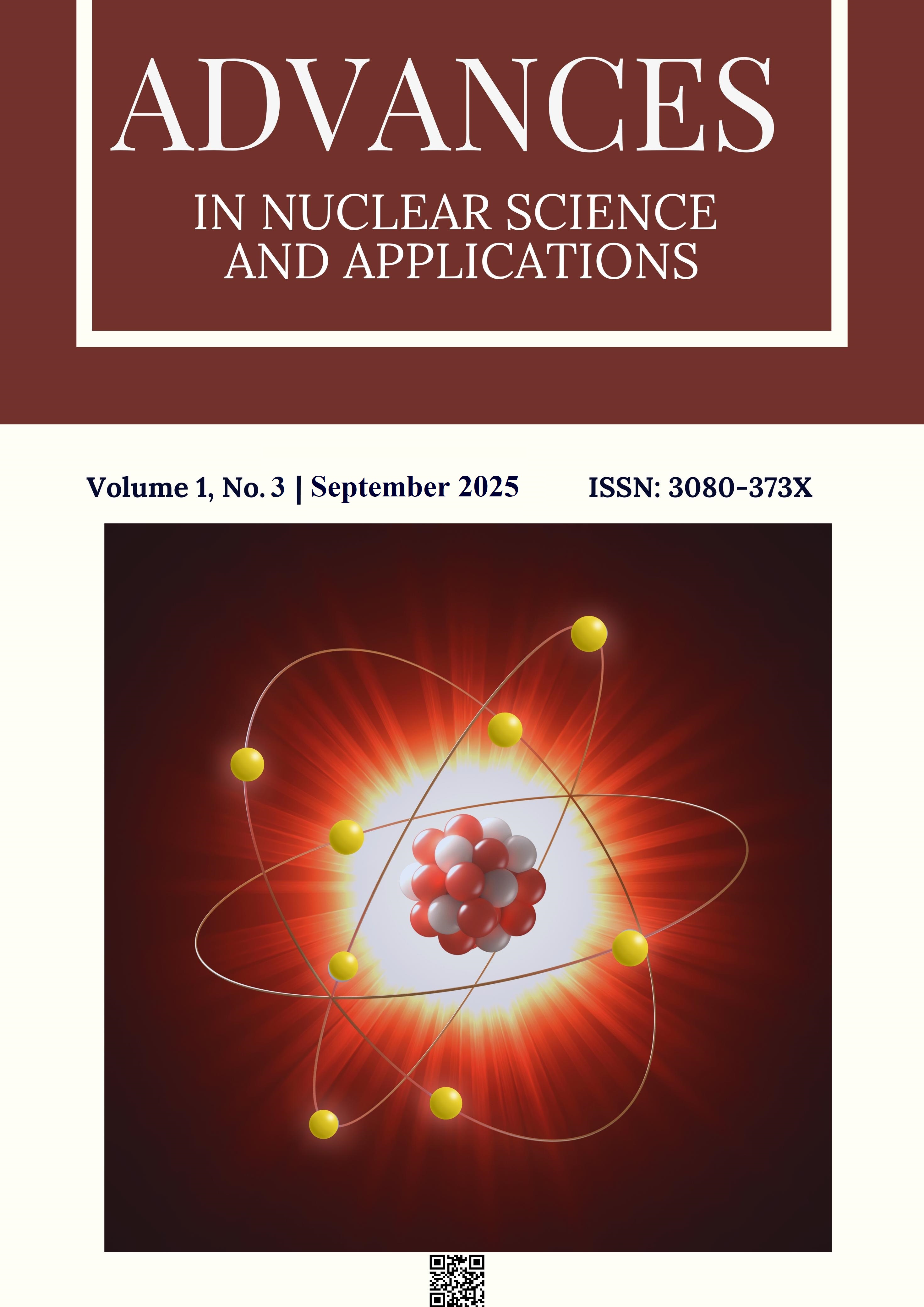Two component ferrofluids and tandem magnetic nanoparticles in nuclear medicine
DOI:
https://doi.org/10.63907/ansa.v1i3.50Keywords:
ferrofluids, magnetic nanoparticles (SPION), nonlinear magnetization, tandem nanoparticles, microfluidicsAbstract
In this article, we systematize nonlinear effects that enable $\textit{configuring}$ magnetic fields inside magnetic nanofluids and ferrofluids at micro- and submillimeter scales for nuclear medicine, and we propose $\textit{tandem}$ magnetic nanoparticles as a realistic platform for combined radionanotherapy and high-precision imaging, provided local sources of $\nabla B$ and standardized radiochemistry. We show how nonlinear magnetization $M(H)$ and field-dependent permeability $\mu(H)$ produce self-focusing of induction and “magnetic pressure”; how the normal-field (Rosensweig) instability generates periodic maps of $\nabla B^{2}$ for capture and sorting; and how dipole-induced self-organization (chains, ribbons, percolation) reshapes the medium’s effective anisotropy and magnetorheology. We consider nonstationary protocols (harmonic and rotating fields) that provide flow rectification and programmable orientation of structures at low Mason number, as well as inverse ferrofluids with negative magnetophoresis for label-free focusing in microchannels. We discuss feedback methods (MPS/MPI) that enable $\textit{in situ}$ mapping of saturation zones, clustering, and tracer distributions. Practical guidelines are formulated: operate near presaturation, combine local flux guides/inserts with a DC gradient and a low-frequency rotating field, and use polydispersity and mixed shapes (spheres+rods) for controlled percolation. Limits of controllability are noted: geometric decay of gradients, saturation, heating in AC regimes, and hysteretic transitions. The target applications are microfluidic concentration, targeted delivery, and selective fixation of nanoparticles, where nonlinear effects are the primary tools for “drawing” internal fields. Two-component magnetic fluids with $\textit{radioactive}$ sources provide flexibility: separate optimization of magnetics and radiochemistry, use nonlinear assembly for internal gradient amplification, and rely on clinically established radioplatforms for dose verification.
References
R.E. Rosensweig, Ferrohydrodynamics (Cambridge Univ. Press, 1985) 344 p.
M.I. Shliomis, Sov. Phys. Usp. 17(2), 153 (1974).
S. Odenbach, S. Thurm, in Ferrofluids, ed. by S. Odenbach, Lecture Notes in Physics, vol. 594 (Springer, Berlin, Heidelberg, 2002).
C. Holm, J.-J. Weis, Current Opinion in Colloid & Interface Science 10, 133 (2005).
A.Y. Zubarev, Physica A 343, 65 (2004).
A.O. Ivanov, A.Y. Zubarev, Materials 13, 3956 (2020).
A. Al Harraq, B. Bharti, Langmuir 38, 3001 (2022).
M. Hejazian, W. Li, N.-T. Nguyen, Lab Chip 15, 2998 (2015).
M. Hejazian, W. Li, N.-T. Nguyen, Biomicrofluidics 10, 044104 (2016).
W. Zhao, Micromachines 7, 40 (2016).
R. Patel, H.J. Choi, B.J. Park, Phys. Rev. E 80, 012401 (2009).
R. Patel et al., J. Magn. Magn. Mater. 9, 515 (2011).
M.I. Shliomis, Phys. Rev. Fluids 6, 043701 (2021).
S. Dalvi et al., Int. J. Heat Fluid Flow 93, 108909 (2022).
M. Sheikholeslami et al., J. Magn. Magn. Mater. 416, 45 (2016).
L. Li et al., Appl. Phys. Lett. 123, 254101 (2023).
A. Lange et al., Phys. Rev. E 93, 043106 (2016).
S.A. Lira, J.A. Miranda, Phys. Rev. E 84, 016303 (2011).
J. Li et al., Sci. Rep. 12, 17986 (2022).
B. Gleich, J. Weizenecker, Nature 435, 1214 (2005).
P.W. Goodwill, S.M. Conolly, IEEE Trans. Med. Imaging 31(2), 496 (2012).
P. Yari et al., Sensors 23, 4411 (2023).
A. Remmo et al., Sci. Rep. 13, 7369 (2023).
A. Remmo et al., Proceedings of the 10th Int. Workshop on Magnetic Particle Imaging, 1 (2022).
S. Thurm, S. Odenbach, J. Magn. Magn. Mater. 252, 247 (2002/2003).
X. Xuan, Micromachines 10, 744 (2019).
A.K. Singh et al., Phys. Rev. E 108, 064604 (2023).
M.S.O. Pijeira, EJNMMI Radiopharm. Chem. 7, 21 (2022).
N. Sun, Theranostics 14, 1583 (2024).
A. Al Harraq, B. Bharti, Langmuir 38, 3001 (2022).
N.A. Gharibkandi, Pharmaceutics 15, 1001 (2023).
C. Caro, Pharmaceutics 13, 416 (2021).
M. Żuk, Materials 15, 5738 (2022).
M. Hejazian, W. Li, N.-T. Nguyen, Lab Chip 15, 2998 (2015).
M. Hejazian, W. Li, N.-T. Nguyen, Biomicrofluidics 10, 044104 (2016).
B. Shapiro, J. Magn. Magn. Mater. 380, 357 (2014).
B. Polyak, Proc. Natl. Acad. Sci. USA 105, 698 (2008).
P.J. Cregg, J. Magn. Magn. Mater. 322, 2060 (2010).
D. Stanković, Pharmaceutics 15, 1943 (2023).
J. Pellico, Chem. Soc. Rev. 50, 8945 (2021).
IAEA, Copper-64 radiopharmaceuticals: production and quality control, IAEA Report (2022).
X. Li, Cancer Nanotechnol. 6, 324 (2025).
Z.A. Bekbol, Nanomaterials 15, 8822 (2025).
F. Ahmad, Bioeng. Transl. Med. 10, e0145 (2025).
M. Stella, Cardiovasc. Intervent. Radiol. 45, 1169 (2022).
L.E.L. Westlund Gotby, EJNMMI Phys. 11, 83 (2024).
P. Sólymos, Cancers 17, 5360 (2025).
C. Comanescu, Biomimetics 7, 63 (2022).
B.Z. Muftuler et al., Int. J. Mol. Sci. 24(6), 5282 (2023).
Downloads
Published
Issue
Section
License
Copyright (c) 2025 Advances in Nuclear Science and Applications

This work is licensed under a Creative Commons Attribution 4.0 International License.






